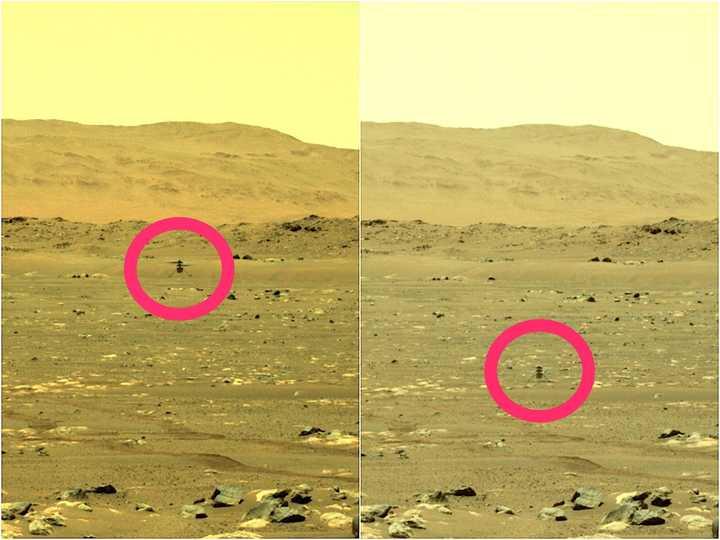NASA's Mars Helicopter Surprisingly...
03
04
NASA's Mars Helicopter Surprisingly Successful... Mission Completed for 15th Flight
A small helicopter Ingenuity drops to the surface of Mars from NASA's Perseverance rover April 5, 2021.

NASA sent a small helicopter, Ingenuity, to Mars, but there was no confidence that the flight would be successful. [See all images] NASA's Mars Helicopter Surprisingly Successful... 15th Flight Completed Mission However, the helicopter flew higher, farther and faster than the engineers had expected. The Ingenuity, which was expected to crash on its fifth flight, has just completed its 15th flight. Engineers at the National Aeronautics and Space Administration (NASA) had an ingenious idea while building the Mars rover Perseverance. "Why don't we take a small helicopter to Mars?" It would be difficult to take off in air that is only 1% denser than Earth's atmosphere. This is like flying at an altitude three times the height of Everest. But NASA wanted to prove it was possible through a technical demonstration. NASA engineers built Ingenuity, a small helicopter the size of a tissue box, and crammed it into the empty space left inside Perseverance. Engineers were unsure if Ingenuity would survive its first night on the cold Martian surface. In addition, I was worried that it would not fly even if I gave commands, and that one of the five scheduled flights would crash. However, Ingenuity has dispelled that anxiety many times. It completed its 15th flight on November 6. NASA is currently analyzing data from this flight. If the flight had gone according to plan, Ingenuity would have risen to a height of about 12 meters above the Martian surface and flew about 400 meters in less than 129 seconds.
NASA Predicted Mars Helicopter Crash
On February 18, 2021, Ingenuity and Perseverance landed in Jezero Crater. This crater is the bed of an ancient dried-up lake. Scientists believe that a Martian microbial ecosystem may have existed in Lake Jezero more than 3.5 billion years ago. If such micro-organisms existed, they might have fossilized in the mineralized rocks deposited at the bottom of the lake. At first, engineers didn't think Ingenuity could fly more than five meters. During the fifth flight in early April, project manager MiMi Aung said the helicopter "will be entering unsurveyed areas and it will be difficult to land safely". was "If the landing fails, the mission is over at that point," she said. "A successful landing determines its lifespan." But Ingenuity has landed at least 14 times (15 if we can confirm a successful landing on its most recent flight). Ingenuity performed so well in its first five flights that NASA extended the mission by 30 days. The sixth flight, the first after the extension, flew over previously unexplored terrain. Since then, I have visited many unexplored places, such as rocky areas and undulating sands. During these flights, Ingenuity took close-up photographs of outcrops and rocky outcrops where the Perseverance team is considering sending rovers. Using the photos, NASA was able to identify a safe, flat route for the rover to follow, as well as the type of rocks in the area. In the future, if Perseverance collects a sample of that rock, it will be a clue to the past of Jezero Crater. Perseverance scientist Ken Farley said at a press conference in April, "The ability to fly helicopters over terrain that rovers can't traverse and bring back scientific data is a huge advantage for rovers and reconnaissance helicopters. It is very important for future missions that combine After Ingenuity survived the 30-day extension, NASA extended the mission's duration even further. They decided to keep the Ingenuity flying until it crashed or the Perseverance operations were compromised. Neither of those have happened yet. In fact, the Ingenuity performs almost all flights flawlessly. Only once in May was a technical glitch causing it to sway back and forth and side to side during flight, but it still landed safely. In the last two flights, NASA spun up the rotors to push the ingenuity even further. To get enough lift in Mars' tenuous atmosphere, Ingenuity would have to rotate its two sets of blades in opposite directions at 2400 revolutions per minute. But now that Jezero Crater is in full swing, the atmosphere is even thinner. As the south pole of Mars is wintering, some of the carbon dioxide in the atmosphere has turned into snow and ice. That's why they've recently sped up their blades to 2,700 rpm. Ingenuity has already made two flights under those conditions. NASA plans four to seven more flights to return Ingenuity to where Perseverance first landed on Mars. However, no further plans have been revealed. Ultimately NASA would like to send a more ambitious helicopter to Mars, and possibly elsewhere. Space drones like Ingenuity will one day survey difficult terrain from above, survey large areas faster than rovers, and even perform reconnaissance for astronauts. will be able to NASA is already conducting missions using such helicopters. In 2027, it plans to launch a helicopter called Dragonfly to Saturn's moon Titan, to see if life exists on the methane-rich Titan. [Original text: NASA engineers expected their Mars helicopter to crash after 5 liftoffs. It just landed its 15th flight.]
Morgan McFall-Johnsen


![[Kill personally developed games] Top class in app history! Too beautiful water puzzle "a [Q] ua" | Famitsu App for smartphone game information [Kill personally developed games] Top class in app history! Too beautiful water puzzle "a [Q] ua" | Famitsu App for smartphone game information](https://website-google-hk.oss-cn-hongkong.aliyuncs.com/drawing/article_results_7/2022/3/3/66755df992ff2d2b1e1ab43844ef9f88_0.jpeg)





![[Latest in 2021] 10 recommended seat covers for cars!If you want to improve the texture and functionality of the car, choose the mounting type and material. [Latest in 2021] 10 recommended seat covers for cars!If you want to improve the texture and functionality of the car, choose the mounting type and material.](https://website-google-hk.oss-cn-hongkong.aliyuncs.com/drawing/article_results_7/2022/3/3/e5b44589e77141f3a633189165fb6f60_0.jpeg)